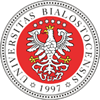Proszę używać tego identyfikatora do cytowań lub wstaw link do tej pozycji:
http://hdl.handle.net/11320/16745| Tytuł: | Sejmiki litewskie 1695 r. wobec klątwy rzuconej na wojewodę wileńskiego i hetmana wielkiego litewskiego Kazimierza Jana Sapiehę |
| Inne tytuły: | Lithuanian Sejmiks 1695 in the face of the curse cast on the Vilna Voivode and Grand Hetman of Lithuania Casimir Jan Sapieha |
| Autorzy: | Sawicki, Mariusz |
| Słowa kluczowe: | Sapiehowie Litwa Brzostowski Jan III Sobieski sejmiki Sapieha family Lithuania |
| Data wydania: | 2024 |
| Data dodania: | 17-cze-2024 |
| Wydawca: | Instytut Badań nad Dziedzictwem Kulturowym Europy oraz Polskie Towarzystwo Historyczne |
| Źródło: | Wobec sejmików. Magnateria Rzeczypospolitej w XVI–XVIII wieku, T. 2, pod red. Marty Kupczewskiej i Karola Łopateckiego, Białystok 2024, s. 349-367 |
| Seria: | Magnateria Rzeczypospolitej w XVI–XVIII wieku; |
| Konferencja: | VI Ogólnopolska konferencja naukowa „Magnateria Rzeczypospolitej w XVI–XVIII wieku. Wobec sejmików”, Ciechanowiec 24–27 maja 2022 r. |
| Abstrakt: | On April 18, 1694, Bishop of Vilna Konstantyn Kazimierz Brzostowski excommunicated Vilna Voivode and Grand Hetman of Lithuania Kazimierz Jan Sapieha. This was another installment of the conflict between the Sapiehas, who ruled in Lithuania, and the opposition to them, led by John III Sobieski. The pretext for such actions by the clergyman was the laying out of Lithuanian military troops on the estates of the Vilna chapter. Although Sapieha did not break the applicable law and customs in this case, the event provided a pretext for the escalation of a conflict that had been growing for some time. It quickly moved to the parliamentary arena, both the Sejm and the sejmiks. To the charge of laying the Lithuanian army to rest, the clergyman quickly added other offenses of the Sapiehas, such as disobeying the law, violating the freedoms of the nobility and, most generally, hegemony. An interesting issue in this case will be the position of the Lithuanian pre-Sejm sejmiks on the curse cast by Brzostowski, which would consequently be the resultant of the support given by the nobility to the Sapiehas or the Bishop of Vilna. Of course, not all the sejmiks supported the all-powerful family in Lithuania – the Sapieha hegemony was not broken, but support for the excommunication was certainly a visible element of the growing revolt against the said family. Taking the side of Brzostowski and the excommunication was by no means an endorsement of the Bishop of Vilna, who did not enjoy an impeccable reputation among the nobility, but an expression of opposition to the Sapiehas and support for the opposition led by John III Sobieski. Translated by Stefan Kubiak |
| Afiliacja: | Uniwersytet Opolski |
| URI: | http://hdl.handle.net/11320/16745 |
| ISBN: | 978-83-64103-96-4 (całość) 978-83-64103-95-7 (t. 2) |
| metadata.dc.identifier.orcid: | 0000-0001-5318-7145 |
| Typ Dokumentu: | Book chapter |
| Właściciel praw: | © Copyright by Instytut Badań nad Dziedzictwem Kulturowym Europy |
| Występuje w kolekcji(ach): | VI Ogólnopolska konferencja naukowa „Magnateria Rzeczypospolitej w XVI–XVIII wieku. Wobec sejmików”, Ciechanowiec 24–27 maja 2022 r. |
Pliki w tej pozycji:
| Plik | Opis | Rozmiar | Format | |
|---|---|---|---|---|
| M_Sawicki_Sejmiki_litewskie.pdf | 207,96 kB | Adobe PDF | Otwórz |
Pozycja jest chroniona prawem autorskim (Copyright © Wszelkie prawa zastrzeżone)

